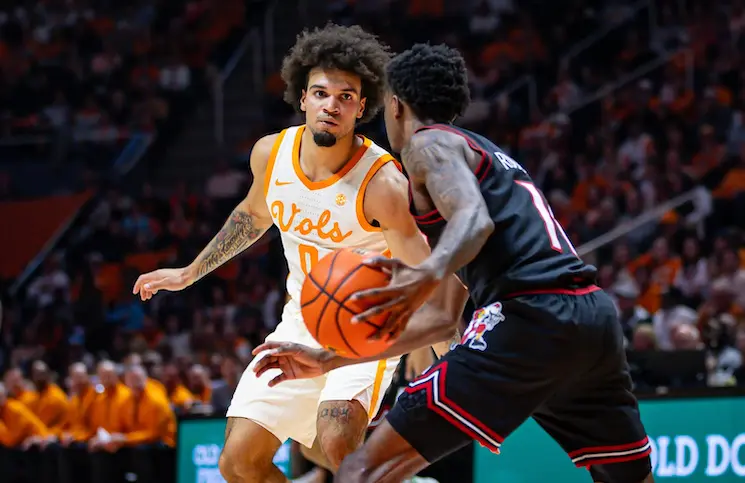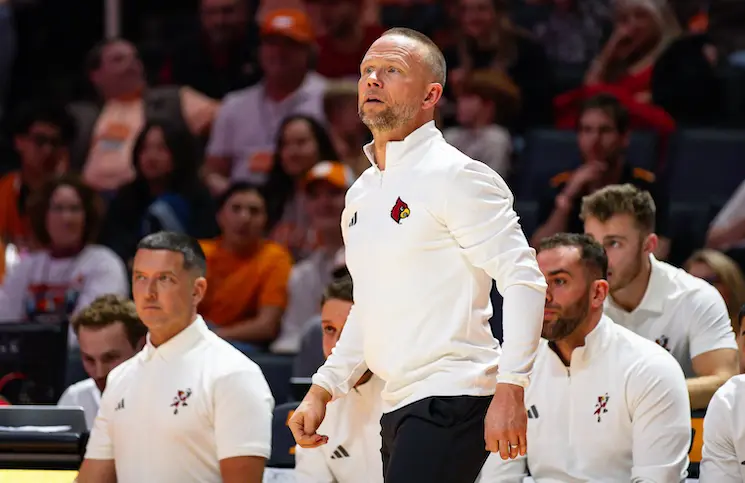
In the 2018-19 season, Tennessee’s men’s basketball program put together one of the best seasons in school history. The Vols rose to No. 1 in the AP Poll for four weeks, and the team was just a few plays away from making it to only the second Elite Eight appearance in program history. Tennessee’s 31 wins in 2018-19 tied the school record for the most wins in a single season, and the Vols had three players taken in the 2019 NBA Draft after the season, marking only the third time in school history that UT had three players selected in the same draft.
Those three players — Grant Williams, Admiral Schofield, and Jordan Bone — weren’t the only contributors the Vols lost off their 2018-19 roster, however.
Starting center Kyle Alexander graduated and found a spot in the G League eventually, and Tennessee had two players transfer off the roster in the offseason as well. Former four-star forward D.J. Burns left due to off-court issues, and forward Derrick Walker also transferred to try and find more playing time elsewhere.
That left Tennessee with only six returning players off the 2018-19 roster for the upcoming 2019-20 season, and only two of those players (Jordan Bowden and Lamonte Turner) averaged more than 12 minutes a game in 2018-19.
Vol fans always knew that the 2019-20 season was going to be a rebuilding/retooling/bridge year for Tennessee. The Vols lost a ton of production and had to replace that with players taking on new roles and several freshmen filling in on the bench.
But that wasn’t all for Tennessee.
Head coach Rick Barnes was hopeful that seven-foot Arizona State transfer Uros Plavsic would be eligible to play to start the season, but the NCAA had other ideas. Plavsic was denied immediate eligibility, and UT threw a Hail Mary appeal to try and get Plavsic on the court eventually. It wouldn’t be until January that Plavsic would finally suit up for the Vols.
Just 11 games into the season, starting point guard Lamonte Turner elected to have season-ending shoulder surgery, bringing his UT career to an abrupt halt. Two games later, Turner was replaced by true freshman and mid-year enrollee Santiago Vescovi — who had practiced with the team for just a week before earning a start in his very first game as a Vol.
All that roster attrition and a fairly difficult schedule saw Tennessee take a huge step back in 2019-20.
The Vols went from competing for the SEC regular season and tournament titles, earning the No. 1 ranking for a month, receiving a No. 2 seed in the NCAA Tournament, and finishing with a 31-6 overall record to going 17-14 before the 2019-20 season was unceremoniously canceled due to the outbreak of the coronavirus.
This year’s UT squad lost seven more games than last year’s team in seven fewer games played.
Given how much turnover Tennessee’s roster faced in the offseason and even as the season went along, finishing 17-14 in the regular season might actually have been a bit surprising. Tennessee played 13 teams ranked in the top 65 of the final NET rankings, and 13 of their opponents also ranked in the top 65 of the Ken Pomeroy rankings. The Vols didn’t have much luck against those teams, with their only wins against top-65 teams coming against Kentucky, Florida, Arkansas, Alabama, and Washington, but Tennessee generally beat the teams ranked lower than them — with the exception of UT’s losses to Georgia and Texas A&M.
Nobody would describe Tennessee as a blue blood program in men’s basketball, and they’ve only recently started recruiting like a top-tier program in the sport. The Vols weren’t equipped to replace all their lost production this season like Duke, Kansas, and Kentucky are every season.
So that begs the question: Was the Vols’ decline this season compared to last year an anomaly across the college basketball world, or was it a normal drop-off?
I took a look at every team that made it as far as Tennessee did in the 2019 NCAA Tournament — the Sweet Sixteen — over the last three years to see how they fared the following season. Of course, we won’t fully know how the teams from the 2019 tournament would’ve done in 2020 because of the cancellation of the season, but it’s still pretty easy to tell which teams took big steps back, which ones saw only minor changes or stayed about the same, and which teams were on track to improve from last year.
All in all, seven of the 16 teams in last year’s Sweet Sixteen experienced what I would call a “significant decline” (four-to-five or more losses from the previous year). That includes Tennessee’s drop from a 31-6 record to a 17-14 mark.
National champion Virginia only experienced four more losses than last season, but it took them having a very strong close to the regular season to avoid being a potential bubble team for the 2020 tournament. The Cavaliers went from 35-3 in 2018-19 to 23-7 at the end of this season. I still included them in the “significant decline” category, however, because there’s no denying they were a much different team this year and likely weren’t going to make another deep tournament run.
But we’ll never know, unfortunately.
Runner-up Texas Tech went from 31-7 to 18-13, Michigan went from 30-7 to 19-12, and both Houston and LSU weren’t as strong as they were in 2018-19, both winning significantly fewer games than the previous year and were likely on track to have four or five more losses than the previous season.
Tennessee’s drop-off wasn’t even close to the biggest of last year’s Sweet Sixteen teams, though.
North Carolina was the obvious black sheep, going from 29-7 in 2018-19 to an abysmal 14-19 this year. Purdue — the team Tennessee lost to in overtime in the Sweet Sixteen — fell from a 26-10 mark last season to just 16-15 this year. Virginia Tech also saw a huge decline, going from 26-9 to 16-16.
Those declines weren’t unique to this past season, either.
In 2018, seven Sweet Sixteen teams either failed to make it back to the Sweet Sixteen in 2019, failed to win a game in the NCAA Tournament, or failed to make it to the tournament altogether. Loyola-Chicago, Villanova, Kansas, Syracuse, and Clemson all had worse seasons in 2018-19 than they did in 2017-18. West Virginia and Texas A&M were the worst offenders, falling to losing records in the 2018-19 seasons after making runs in the NCAA Tournament in 2018.
The previous year in 2017 saw nine of the Sweet Sixteen teams have worse seasons in 2017-18 after making it to the round of 16 in 2017. Arizona and North Carolina all took steps back, and South Carolina, UCLA, and Wisconsin all saw massive declines from 2016-17 to 2017-18.
In total, almost half (23 of 48) of the teams who made it to at least the Sweet Sixteen in the last three NCAA Tournaments went on to have noticeably worse seasons the next year.
Watching the Vols’ decline in play this season was frustrating for Vol fans, but it was far from an aberration. In fact, unless you’re a program like Duke, Kentucky, Gonzaga, or other blue blood programs, taking a step back after a decent run in the NCAA Tournament is almost expected.
Tennessee hasn’t been the type of program that can recover from the losses they suffered this past offseason and early this season, but they’re working on getting to that point. The Vols signed an elite recruiting class in the 2020 cycle, and UT is working on adding to that with another strong class in the 2021 cycle.
These types of drop-offs will hopefully be less commonplace in the future for Tennessee, but their noticeable dip in play this season isn’t uncommon when you look at the entire landscape of college basketball.
Here’s a look at the full breakdown of Sweet Sixteen teams over the last three NCAA Tournaments:
2018-19 to 2019-20
Duke — 32-6 to 25-6
Michigan State — 32-7 to 22-9
LSU — 28-7 to 21-10
Gonzaga — 33-4 to 31-2
Florida State — 29-8 to 26-5
Texas Tech — 31-7 to 18-13
Michigan — 30-7 to 19-12
Houston — 33-4 to 23-8
North Carolina — 29-7 to 14-19
Purdue — 26-10 to 16-15
Virginia — 35-3 to 23-7
Auburn — 30-10 to 25-6
Kentucky — 30-7 to 25-6
Tennessee — 31-6 to 17-14
Virginia Tech — 26-9 to 16-16
Oregon — 25-13 to 24-7
2017-18 to 2018-19
Duke — 29-8 to 32-6
Nevada — 29-8 to 29-5
Loyola-Chicago — 32-6 to 20-14
Gonzaga — 32-5 to 33-4
Florida State — 23-12 to 29-8
Texas Tech — 27-10 to 31-7
Michigan — 33-8 to 30-7
Kansas State — 25-12 to 25-9
Villanova — 36-4 to 26-10
Purdue — 30-7 to 26-10
West Virginia — 26-11 to 15-21
Kansas — 31-8 to 26-10
Kentucky — 26-11 to 30-7
Texas A&M — 22-13 to 14-18
Syracuse — 23-14 to 20-14
Clemson — 25-10 to 20-14
2016-17 to 2017-18
Wisconsin — 27-10 to 15-18
Florida — 27-9 to 21-13
Baylor — 27-8 to 19-15
Gonzaga — 37-2 to 32-5
South Carolina — 26-11 to 17-16
Xavier — 24-14 to 29-6
Michigan — 26-12 to 33-8
Arizona — 32-5 to 27-8
North Carolina — 33-7 to 26-11
Purdue — 27-8 to 30-7
West Virginia — 28-9 to 26-11
Kansas — 31-5 to 31-8
Kentucky — 32-6 to 26-11
UCLA — 31-5 to 21-12
Butler — 25-9 to 21-14
Oregon — 33-6 to 23-13




One Response
Rick Barnes completely failed in recruiting. You are giving him a pass on how miserably he mismanaged his roster from year to year. Rebuilding in year 5 is ridiculous for the 4th highest paid coach in America. Almost half the players he has signed have beem complete busts.